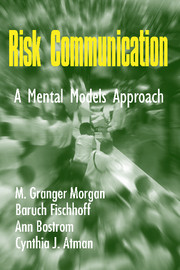Book contents
- Frontmatter
- Contents
- Preface
- Risk Communication
- 1 INTRODUCTION
- 2 OUR MENTAL MODELS APPROACH
- 3 CREATING AN EXPERT MODEL OF THE RISK
- 4 MENTAL MODELS INTERVIEWS
- 5 CONFIRMATORY QUESTIONNAIRES
- 6 DEVELOPMENT AND EVALUATION OF COMMUNICATIONS
- 7 CASE STUDIES: APPLICATIONS TO ENVIRONMENTAL RISKS
- 8 A MENTAL MODELS APPROACH TO HIV/AIDS
- 9 SOME CONCLUDING THOUGHTS
- Appendix A Brochure on global warming and climate change
- Appendix B Brochure on fields from electric power
- Appendix C Risk communication materials on HIV/AIDS
- Appendix D Sample transcripts of mental model interviews
- Index
8 - A MENTAL MODELS APPROACH TO HIV/AIDS
Published online by Cambridge University Press: 05 June 2012
- Frontmatter
- Contents
- Preface
- Risk Communication
- 1 INTRODUCTION
- 2 OUR MENTAL MODELS APPROACH
- 3 CREATING AN EXPERT MODEL OF THE RISK
- 4 MENTAL MODELS INTERVIEWS
- 5 CONFIRMATORY QUESTIONNAIRES
- 6 DEVELOPMENT AND EVALUATION OF COMMUNICATIONS
- 7 CASE STUDIES: APPLICATIONS TO ENVIRONMENTAL RISKS
- 8 A MENTAL MODELS APPROACH TO HIV/AIDS
- 9 SOME CONCLUDING THOUGHTS
- Appendix A Brochure on global warming and climate change
- Appendix B Brochure on fields from electric power
- Appendix C Risk communication materials on HIV/AIDS
- Appendix D Sample transcripts of mental model interviews
- Index
Summary
Since early in the HIV/AIDS epidemic, it has been apparent that people's understanding of its risks are a primary public health concern. People must learn to avoid some behaviors (e.g., unsafe sex, sharing IV drug needles) while not avoiding others (e.g., giving blood, living and learning with infected individuals). As with many other risks, the information that people need is both quantitative and qualitative. For example, they require both a credible estimate of the prevalence of contaminated blood and a feeling for signs that their blood bank or drug partner is above (or below) that average. Moreover, an understanding of how the risks are created and controlled may be essential for making quantitative estimates intuitively plausible (e.g., “how could it be that condoms only reduce risks by a factor of 10?”). That understanding may also provide the feelings of self-efficacy needed to deal with an issue, and to lead others toward appropriate behavior.
Recognizing these factors, public health officials have invested extensive resources into getting the message out about HIV/AIDS (CDC, 1994; Institute of Medicine, 1996). These efforts have included TV spots and specials, school posters and pamphlets, as well as courses and curricula. Considering the magnitude of this effort and the stakes riding on its success, it is essential that the content of the messages be appropriate. This chapter reports an application of the mental models approach to this task.
- Type
- Chapter
- Information
- Risk CommunicationA Mental Models Approach, pp. 160 - 178Publisher: Cambridge University PressPrint publication year: 2001

